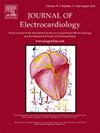Residual-attention deep learning model for atrial fibrillation detection from Holter recordings
IF 1.3
4区 医学
Q3 CARDIAC & CARDIOVASCULAR SYSTEMS
引用次数: 0
Abstract
Background
Detecting subtle patterns of atrial fibrillation (AF) and irregularities in Holter recordings is intricate and unscalable if done manually. Artificial intelligence-based techniques can be beneficial. In fact, with the rapid advancement of AI, deep learning (DL) demonstrated the capability to identify AF from ECGs with significant performance. However, further development and validation on larger cohorts is still needed.
Purpose
The main purpose of this study was to develop a Residual-attention DL model by considering a large cohort of 2‑lead Holter recordings.
Methods
We developed a residual DL model by collecting a large dataset of 661 Holter recordings, which was labeled manually by an expert cardiologist. The DL model leveraged attention mechanisms, allowing it to capture long-range dependencies and intricate temporal relationships crucial for identifying subtle patterns indicative of AF.
Results
Experimental results demonstrated that our model achieved a sensitivity (detection of AF) of and a specificity of , with an AUC-ROC of on our dataset. Additionally, when evaluated with an external test dataset, specifically IRIDIA-AF, our DL model obtained , , and . Finally, when compared under similar experimental conditions with other state-of-the-art models, our DL model achieved slightly better performance overall.
Conclusion
The Residual-attention DL model we proposed offers a promising solution for AF detection. The validation on external datasets contributes to its potential for deployment in clinical settings, providing clinicians with a valuable decision support system.
基于动态心电图记录的房颤检测的剩余注意深度学习模型。
背景:检测心房颤动(AF)的细微模式和动态心电图记录的不规则性是复杂的和不可扩展的,如果手工完成。基于人工智能的技术可能是有益的。事实上,随着人工智能的快速发展,深度学习(DL)证明了从心电图中识别AF的能力,并取得了显著的成绩。然而,仍需要在更大的人群中进行进一步的开发和验证。目的:本研究的主要目的是通过考虑大量双导联霍尔特记录来建立一个剩余注意深度学习模型。方法:通过收集661个动态心电图记录的大数据集,由心脏病专家手动标记,建立了残差DL模型。DL模型利用了注意机制,使其能够捕获远程依赖关系和复杂的时间关系,这对于识别AF的微妙模式至关重要。结果:实验结果表明,我们的模型在我们的数据集上实现了Se=0.928的灵敏度(检测AF)和Sp=0.915的特异性,AUC- roc =0.967。此外,当使用外部测试数据集(特别是IRIDIA-AF)进行评估时,我们的DL模型获得Se=0.942, Sp=0.932, AUC=0.965。最后,当在类似的实验条件下与其他最先进的模型进行比较时,我们的DL模型总体上取得了稍好的性能。结论:我们提出的剩余注意深度学习模型为房颤检测提供了一个有前途的解决方案。外部数据集的验证有助于其在临床环境中部署的潜力,为临床医生提供有价值的决策支持系统。
本文章由计算机程序翻译,如有差异,请以英文原文为准。
求助全文
约1分钟内获得全文
求助全文
来源期刊

Journal of electrocardiology
医学-心血管系统
CiteScore
2.70
自引率
7.70%
发文量
152
审稿时长
38 days
期刊介绍:
The Journal of Electrocardiology is devoted exclusively to clinical and experimental studies of the electrical activities of the heart. It seeks to contribute significantly to the accuracy of diagnosis and prognosis and the effective treatment, prevention, or delay of heart disease. Editorial contents include electrocardiography, vectorcardiography, arrhythmias, membrane action potential, cardiac pacing, monitoring defibrillation, instrumentation, drug effects, and computer applications.
 求助内容:
求助内容: 应助结果提醒方式:
应助结果提醒方式:


